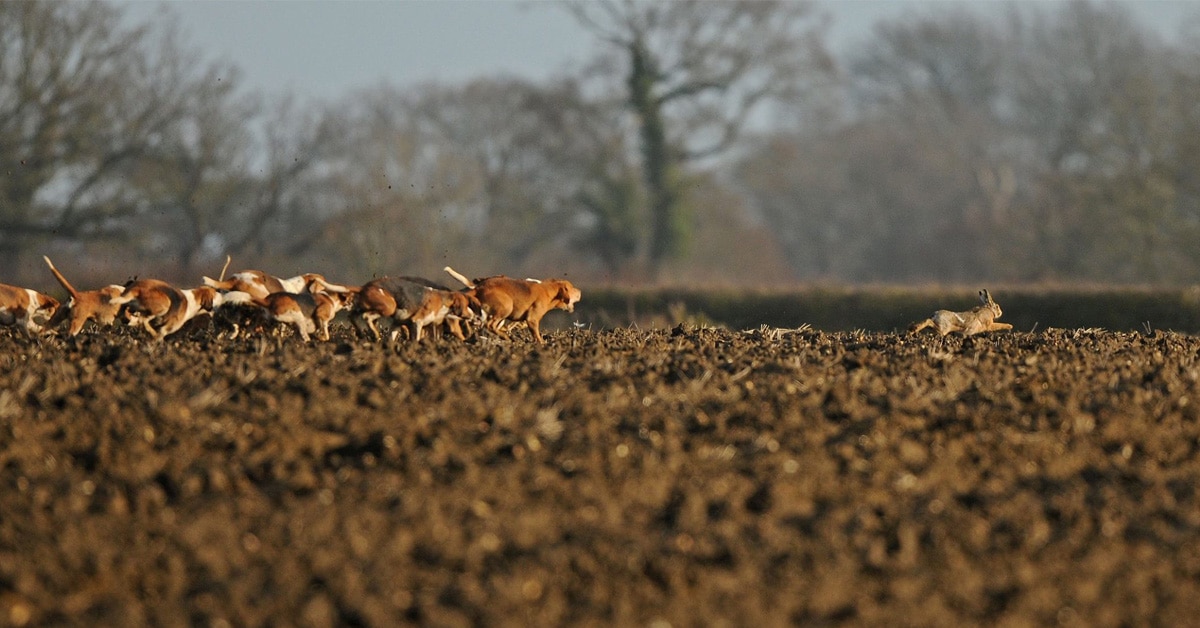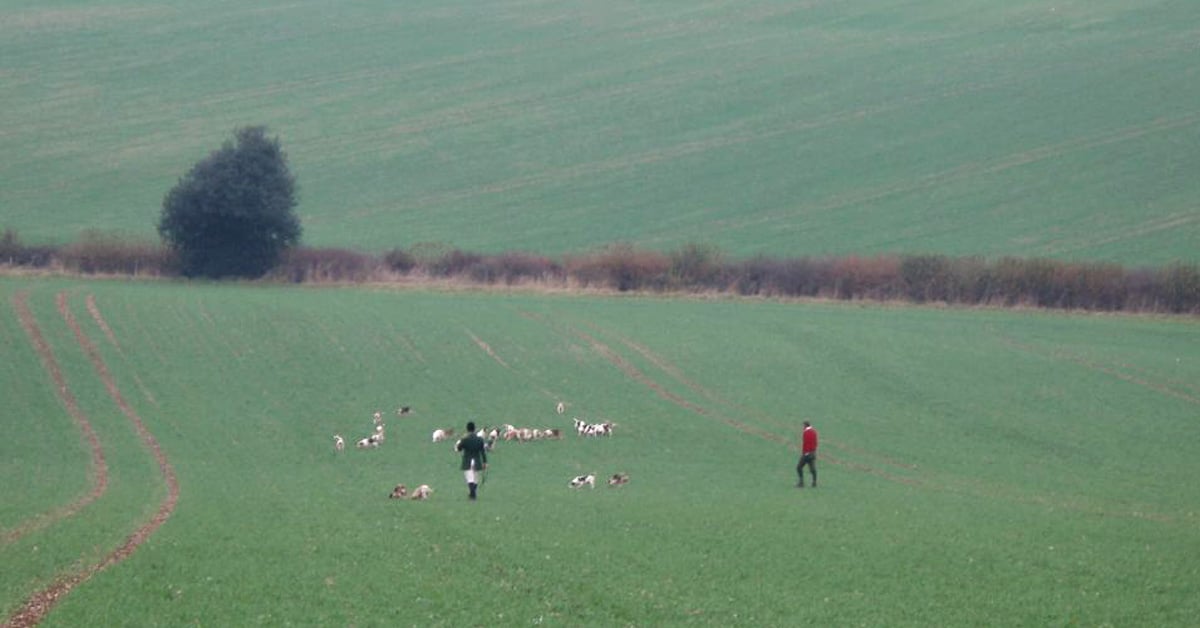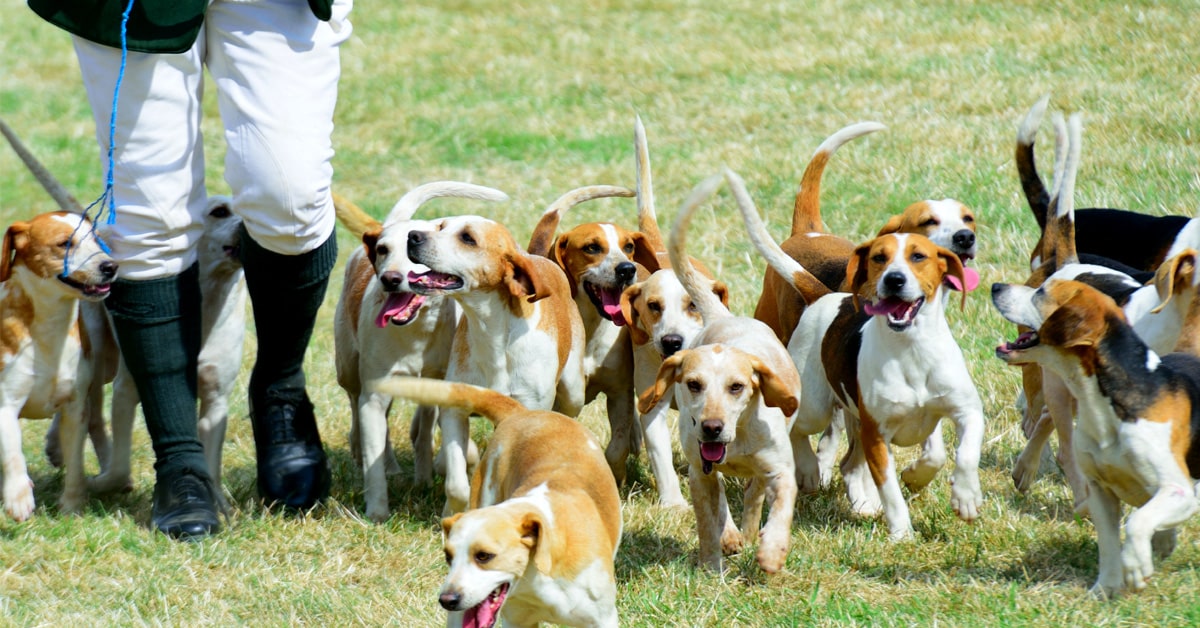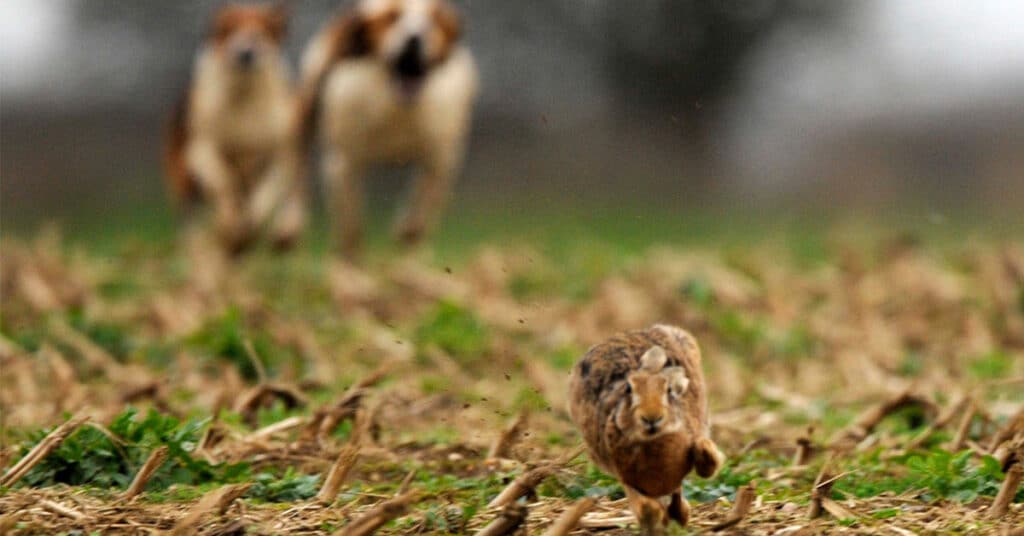Hare hunting is less common and less well-known than fox hunting. However, it still occurs across the UK every week. Hare hunting is distinct from coursing in its use of scent hounds such as beagles and harriers; coursing uses sight hounds such as greyhounds and salukis.
So what is hare hunting and how is it prevented?
There are two different species of hares in the UK: the brown hare and the mountain hare. It’s only the brown hare that’s hunted with hounds, although mountain hares face their own existential dangers. When understanding hare hunting, it’s best to first understand the life and behaviour of the brown hare or lepus europaeus.
The hare
Brown hares are the country’s fastest land mammal, capable of reaching speeds up to 45mph, and can sustain speeds of more than 30mph over long distances. This speed and stamina is their primary form of defence. This is coupled with incredible acceleration. Studies show hares can accelerate at 4.4m/s2, which is nearly twice as fast as the fastest human runner. Hares spend their entire lives above ground so their speed, acceleration and stamina is their means of escaping predators including hunting hounds.

However, they also make good use of camouflage. The variegated sandy colouring of a hare’s fur provides excellent visual camouflage amongst its natural habitat of open fields. Although hares lack a long-term ‘home’ (such as a rabbit’s warren), they will press themselves into the ground to create ‘forms’ or ‘scrapes’ in which they will rest. When predators are nearby, hares will first press themselves into the form in hope of escaping the predator, choosing to run only when there’s no other option for survival.
When hares are chased, they have a range of tricks and tactics that can help them confuse and escape their predator. Simon Carnell writes in Hare that they have:
developed relatively complex escape and concealment strategies in addition to speed, endurance and camouflage. They cam swim, even on occasion into the sea when hard pressed. The brown hare in particular employs elaborate mean to confuse its scent trail, including doubling back on its tracks; leaping sideways to break the trail; entering and leaving its form in ways designed to construct a ‘maze’ for predators hunting by scent. They also establish regular routes of ‘racetracks’ in the vicinity of their forms, and ‘meuses’ or gaps in hedges and fences facilitating rapid egress from enclosed fields.
Hares are fast, agile and intelligent creatures. For this reason hare hunting was once the most widespread form of hunting with hounds, though practiced largely on foot at the time, because stag hunting was reserved exclusively for aristocracy and royalty. This was overtaken by fox hunting due to various factors including field enclosures and a greater desire for mounted hunting. Nonetheless, hare hunting persisted and continues until today.
Hunting the hare

Hare hunting with hounds in the UK today is conducted with three different breeds of scent hounds: beagles, harriers and bassets.
Beagles
Beagle packs are by far the most numerous, with approximately 40 packs active across England, Wales and Northern Ireland at the time of publishing. There are no active packs in Scotland.
Beagles themselves are significantly smaller than foxhounds although they usually share similar black and tan pied colouring. Pack size is somewhat smaller than foxhounds in that a full pack could number around 15 to 18 couple (30 to 36 hounds). Their biggest distinction is that beagle packs are hunted on foot, which results in a style very different from fox hunting. First and foremost, hunting is primarily conducted across open fields rather than through coverts such as woodland. This, of course, is because hares live in fields. The huntsman will cast the pack across the field in a “wide front” in order to force or ‘put up’ a hare from its form. If a straight case fails to find a hare, but the huntsman knows there are hares in the field, they may then cast the hounds in a circle back around the same field.

Once running, the hare will use its speed and agility to get away from the hounds, including ‘tricks’ to try and confuse them. One such trick is running in a wide circle before continuing through to the next field, giving rise to the iconic image of beagles wheeling around a field. Hares will also try to return to their original form over time, so an extended chase may look like a large circle when mapped out. Hares will also run in straight lines over long distances if necessary, especially if they’re unfamiliar with the territory.
During the chase, the huntsman and whipper in will do their best to keep up with the hounds. Obviously won’t always be possible and it wouldn’t be unusual for a beagle pack to be a long way ahead of the hunt and its followers. Nonetheless, the distances covered by hare hunts tend to be smaller than fox hunts and so the county needed for any one meet is smaller than for a fox hunt.
Hares are faster than beagles, so the intention of the hunt is not to outrun the hare. Instead, as in stag hunting, the aim is usually for the pack to exhaust the hare before killing it. A single chase may last anywhere between just a few minutes up to several hours, although it’s more often than not likely to be at the lower end of this range. Much of this time will be spent across open fields, although hares will run through woodland, hedgerows and other coverts if necessary.
Although hare hunting doesn’t have a direct analogue to cub hunting, they will often use the early part of the season to train hounds on young hares, or leverets. This provides the hunt a chance to “get the pack well blooded” before the main part of the season begins. Early season hunting will look similar to main season hunting except that hunters might encourage faster kills rather than long chases.

Members of the hunt will often look a lot like fox hunters in their clothing, including occasionally the strange tradition of headwear that looks like a riding helmet despite not being mounted. Flat caps are also worn. Instead of riding boots, the hunt will usually wear walking boots combined with long socks. The most significant difference is the green jacket traditionally worn by hare hunters (including harriers and bassets), although there are exceptions such as the Warwickshire Beagles who wear a ‘mulberry’ jacket. The hunt is made up of a huntsman who is often also the master, as well as whipper-ins.
Beagling is banned by the Hunting Act. Should a hunt get caught with its pants down, the most common excuses it will use are trail hunting or rabbit hunting.
Harriers
Harrier packs differ from beagles and bassets in that today they are almost always hunted on horse (though historically there were also ‘foot harrier’ packs). There are about 15 harrier packs in the UK at the time of publishing, all of which are in England and Wales. Traditionally harriers would hunt both hares and foxes, although today most harrier packs seem more likely to hunt foxes. The remaining hare-only harrier packs are few and far between, and shutting down quickly.

In size, the hounds are larger than beagles but smaller than foxhounds. This affords them a greater speed than beagles, though slower than foxhounds, so a day’s hare hunting with harriers will be much faster and cover greater distances. And whilst many harriers are pied, the West Country Harrier breed is often all-white. The behaviour of the hounds and the hunt is essentially similar to beagling. The huntsman will cast hounds across open fields to put up or pick up the scent of a hare and, once found, allow the hounds to chase them. Because the hunt and its followers are mounted, they are better able to keep up with the hounds.
As with beagle packs, hunt masters and servants usually wear green jackets alongside the standard riding regalia. There are exceptions such as the Dunston Harriers and Holcombe Hunt who wear fox hunting scarlet (or ‘pinks’).
Bassets
Bassets are the most unique of the regular hare hunting scent hounds. They are notably smaller than beagles with much shorter legs. Like beagles, bassets are hunted on foot but their smaller stature and shorter legs mean a basset pack hunt is even slower than beagling. For the people that enjoy this pursuit, the slow speed of bassets provides greater opportunities to watch the ‘hound work’. Those interested in the speed and chase of hunting will likely find bassets too slow a pastime. As a result basset packs are the fewest of the three types of hound packs, with around half a dozen currently active in the UK. All of these are based in England.

Basset hunts use the same basic approach to hunting hares as beagles and harriers. Bassets will be cast in a wide scatter in order to put up a hare, and the huntsman may cast the bassets in both a line and a circle depending on their determination to find a hare in the field. Bassets will stick almost exclusively to open field. Due to the slow speed, chases with bassets could last much longer than with beagles or harriers, with some reports of chases more than three hours long.
As with other forms of hunting, there is a huntsman (who is often also a master) and whips, with followers on foot. They will be dressed similarly to beagle packs, usually in green jackets although some such as the Albany and West Lodge Bassets wear yellow. And similarly to beagles, because they are on foot, basset packs are unlikely to hunt if sabs or monitors arrive.
Stopping the hunt
Sabbing beagle and basset packs today is often a case of simply turning up. Because they hunt on foot, they are unable to outrun or escape sabs. That makes continuing with the day’s hunting extremely difficult. However, if the hunt does decide to continue then disrupting it uses tactics similar to fox hunting: getting in front of the hounds, rating them off, and taking control of the pack. However, because there can be multiple hares in a single field, extra care must be taken by people in the field not to put hares up in front of hounds.
This video by Severn Vale Hunt Saboteurs and this one from East Kent Sabs provide visual examples of what sabbing hare hunts looks like.
Harrier packs are less vulnerable to sabbing simply by virtue of being on horseback. That means simply turning up isn’t likely to stop harrier packs from hunting. Sabbing harriers is similar to sabbing beagles although it may require the relaying between groups of sabs as seen in fox hunting.
As with fox hunting, the most likely excuse used by hare hunts is so-called trail hunting. But this is, of course, no more true for hare hunts than it is for fox hunts.
Hare hunting exists in the shadow of fox hunting but is no less despicable or cruel. Consider supporting sab groups that focus on disrupting hare hunts include Severn Vale Hunt Saboteurs and Berkshire Hunt Saboteurs.
Featured image by Hare Preservation Trust Investigations Team. Additional images by Hare Preservation Trust Investigations Team except where noted.

